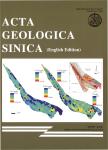Revision to Kowalskia from the Houhecun Fauna and a New Discovery of Tscherskia(Cricetidae, Rodentia) from the Youhe Fauna of Weinan, Shaanxi Province, China
Revision to Kowalskia from the Houhecun Fauna and a New Discovery of Tscherskia(Cricetidae, Rodentia) from the Youhe Fauna of Weinan, Shaanxi Province, China作者机构:State Key Laboratory of Continental DynamicsDepartment of GeologyNorthwest University 229 North Taibai RoadXi'an 710069China
出 版 物:《Acta Geologica Sinica(English Edition)》 (地质学报(英文版))
年 卷 期:2021年第95卷第4期
页 面:1073-1079页
核心收录:
学科分类:070903[理学-古生物学与地层学(含:古人类学)] 0709[理学-地质学] 0819[工学-矿业工程] 07[理学] 0818[工学-地质资源与地质工程] 0708[理学-地球物理学] 0816[工学-测绘科学与技术]
基 金:supported by the National Natural Science Foundation of China (Grant No. 41372020, 41472013) the Northwest University Graduate Innovation and Creativity Funds (Grant No. YZZ17197)
主 题:Houhecun fauna Youhe fauna Sinocricetus Tscherskia Kowalskia Neocricetodon
摘 要:The fossil hamster(an isolated m1) from the early Early Pleistocene Houhecun fauna found in Dali, Weinan, Shaanxi, China, originally identified as Kowalskia dalinica, is reexamined. Its unique characters, including a high crown, very small degree of division of the anteroconid and relatively large size, is taken as evidence of its attribution to the genus Sinocricetus, instead of Kowalskia(junior synonym of Neocricetodon) suggested by the original author. Therefore, the specific name of the species established based on this m1 should be changed to S. dalinicus(Wang, 1988). S. dalinicus probably has a relatively close affinity with S. major Li, 2010, but there are still some obvious differences of characters between them. The discovery of S. dalinicus in the Houhecun fauna confirms that the genus indeed survived into the Pleistocene. A broken hamster mandible, which was found in Weinan, Shaanxi, China and belongs to the late Pliocene Youhe fauna, is also described here and identified as Tscherskia sp.. This specimen represents the earliest Tscherskia in Asia so far, but fails to refute the hypothesis that the genus originated in Europe during the early Pliocene.



